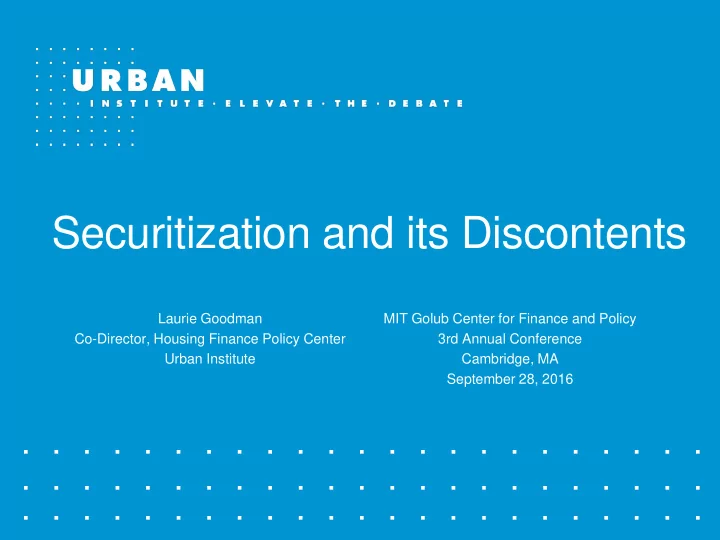

Securitization and its Discontents Laurie Goodman MIT Golub Center for Finance and Policy Co-Director, Housing Finance Policy Center 3rd Annual Conference Urban Institute Cambridge, MA September 28, 2016
Outline • While most other securitized asset classes have come back after the financial crises, residential MBS has not. • There are 3 reasons for this: • Mortgages exhibited the most severe dislocations of any asset class • Mortgages were the only asset class to experience significant policy changes affecting already outstanding securities • Though the interests of investors and issuers were largely aligned in the securitizations of other asset classes, private-label securitization was riddled with conflicts of interest among all of the key players • This cannot be explained by the much large role for the government in the MBS Market • What has to change in the PLS Market to restore issuance? • Standardization, introduction of a deal agent, better transparency and monitoring on servicing 2
Securitization of non-mortgage asset classes $ Billions 250 200 150 Auto CMBS 100 High-yield CLO Credit card 50 Student Loan 0 2000 2001 2002 2003 2004 2005 2006 2007 2008 2009 2010 2011 2012 2013 2014 2015 Sources: Securities Industry and Financial Markets Association and Urban Institute. 3
Private Label RMBS (PLS) Issuance $ Billions 1,400 1,200 1,000 Re-REMICs and other $2160 $8770 Scratch and dent 800 $560 Alt A $160 $3680 Subprime 600 Prime 400 200 0 2001 2002 2003 2004 2005 2006 2007 2008 2009 2010 2011 2012 2013 2014 2015 2016 Q1-2 Source : Inside Mortgage Finance and Urban Institute 4
Percent change in securities issuance from 2001 to 2015 Types of Debt Auto 14.4% Credit card -22.9% Student -5.3% High-yield CLO 155.8% CMBS 58.8% Private Label RMBS -84.2% Source: Urban Institute 5
Delinquency rates by loan product Percent Percent change, 2003-2010 Mortgage 624.6% 16 Auto 123.9% Credit Card 51.2% 14 Student Loan 44.9% 12 11.6% 10 Student Loan 8.2% 8 Credit Card Auto 6 Mortgage 4 3.4% 2 2.3% 0 2003 2004 2005 2006 2007 2008 2009 2010 2011 2012 2013 2014 2015 Sources : Federal Reserve Bank of New York Quarterly Report on Household Debt and Credit and Urban Institute. 6
Why has the private label RMBS market not come back? • Mortgages exhibited the most severe dislocations of any asset class • Exposed weaknesses in the cash flow waterfall • Exposed weaknesses in the collateral underwriting process • Exposed the lack of consistent loan level information • Exposed the sloppy due diligence • Mortgages were the only asset class the experience significant policy changes after the crises • Lack of disclosure for the wave of mortgage modifications • Servicing settlements • Expansion of timelines • Eminent domain 7
Why has the private label RMBS market not come back? • Securitizations of other asset classes have better alignment of interests between the issuer and investors. • Major Issues Include: • Enforcement of reps and warranties • Misplaced incentives due to ownership of second liens • Vertical integration in the servicing process 8
Cumulative Modifications and Liquidations Number of loans (millions) 9 8.1 8 7 6.3 6 HAMP mods 5 Proprietary mods 4 Liquidations 3 1.6 Sources: Hope Now Reports 2 and Urban Institute. Note: Liquidations includes 1 both foreclosure sales and short sales . 0 2007 2008 2009 2010 2011 2012 2013 2014 2015 2016 (Q3-Q4) July 2016 9
First Lien Share by Funding Source ($ trillions) $4.0 Portfolio PLS securitization $3.5 FHA/VA securitization GSE securitization $3.0 $2.5 $2.0 $1.5 $1.0 0.30 0.004 $0.5 0.20 0.38 $0.0 2001 2002 2003 2004 2005 2006 2007 2008 2009 2010 2011 2012 2013 2014 2015 2016 Q1-2 Sources : Inside Mortgage Finance and Urban Institute 10
Recommend
More recommend